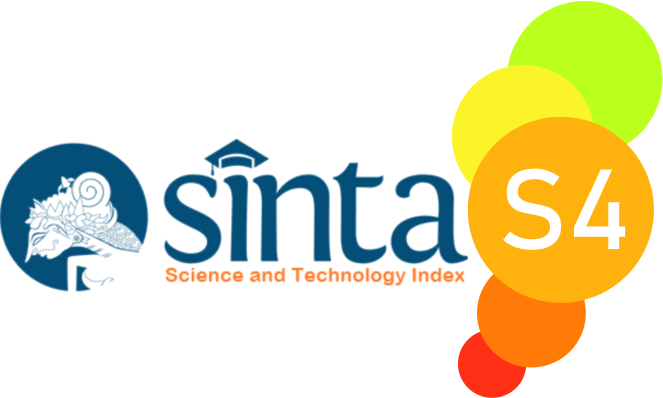Epenthesis in Elementary School
Abstract
Focus of this research was regarding epenthesis in written words of students in Pasir luhur elementary school, Bandung. the writer assumed to identify [1] the way of epenthesis that is written by students and [2] which grapheme that will be found frequently add the written words. The researcher used descriptive qualitative research methods in this study, which meant that participants were involved in case studies that produced narratives and descriptive explanations about settings or practices. The object of exploration that the writer analyzed in this study is the handwriting made by 10 representative students in one classroom. From the analysis, the writer found a way that made the result of written word became so identic. The results of the research showed that the students experienced epenthesis by added certain letter in the middle of word. The most frequently epenthesis happened is in consonant grapheme. this research can add to the literature for other researchers in the field of psycholinguistics and become a reference for other researcher for linguistic studies.
References
Bansal, S. K. (2019). A Study on Language Disorders in Learners. ResearchGate, December, 178–185. https://www.researchgate.net/publication/338117828
Black, A., Ritchie, G., Pulman, S., & Russell, G. (1986). Formalisms for Morphographemic Description. 11–18.
Both, C. A. (2016). Phonological Phenomena of Hungarian Loanwords in the Romanian Language. Acta Universitatis Sapientiae, Philologica, 8(3), 117–126. https://doi.org/10.1515/ausp-2016-0035
Bussmann, H. (1996). Routledge Dictionary of Language and Linguistics (G. Trauth & K. Kazzazi (eds.)). Routledge.
Cenoz, J., Hufeisen, B., & Jessner, U. (Eds.). (2001). Cross-Linguistic Influence in Third Language Acquisition: Psycholinguistic Perspectives. Cromwell Press Ltd.
Crouch, A. L., & Jakubecy, J. J. (2007). Dysgraphia: How it affects a student’s performance and what can be done about it. TEACHING Exceptional Children Plus, 3(1), 267–271.
Ditiya, N. (2017). Indonesian Loan Words as Pronounced by Minangkabaunese Sellers in Citra Niaga Market Jombang East Java a Study on Phonological Processes [Universitas Brawijaya]. http://repository.ub.ac.id/2270/1/NIKITA DITIYA.pdf
Gelb, I. J. (1970). A note on morphographemics. In Mélanges Marcel Cohen: Etudes de linguistique, éthnographie et sciences connexes offertes par ses amis et ses élèves à l’occasion de son 80ème anniversaire (p. 5). De Gruyter Mouton. https://doi.org/https://doi.org/10.1515/9783110878936-006
Harley, Trevor A. 2001. The Psychology of Language: from Theory to Data (edisi kedua). East Sussex: Psychology Press Ltd.
Herchensohn, Julia, 2007. Language Development and Age. New York: Cambridge University press.
Jain, S. (2019). Research Methodology in Arts, Science and Humanities. Society Publishing.
Johnson, S. (2021, February 5). What Is Metathesis? https://www.infobloom.com/what-is-metathesis.htm
Kidd, E, Donnelly, S., & Christiansen, M.H. (2018). Individual Differences in Language Acquisition and Processing. Trends in Cognitive Sciences, 22 (2), 154-169.
Kurniafita, Atika. (2021). GRAMMATICAL ERROR ANALYSIS ON THE FIRST GRADE OF OLYMPIAD STUDENT’S DESCRIPTIVE TEXT AT SMP ISLAM 02 PUJON. Journey: Journal of English Language and Pedagogy, 4(1), 19-22. https://doi.org/10.33503/journey.v4i1.1254
Lerner, J. (2000). Leaning Disabilities: Theories, Diagnosis, and Teaching Strategies. Hughton Miffilin Company.
Luelsdorff, P. A. (1991). Developmental Orthography. John Benjamins Publishing.
McManis, Carolyn et al. (1998). Language Files 4th edition. Department of Linguistic the Ohio State University.
Nayak, J. K., & Sing, P. (2015). Fundamentals of Research Methodology: Problems and Prospects. SSDN Publishers and Distributors. https://doi.org/10.3926/oss.38em
O’Grady, W., Dobrovolsky, M., Katamba, F. 1997. Contemporary lingustics: an introduction. Hong Kong : Longman Asia Limited.
Pedersen, L. (2016). English as a third language in Norwegian schools - A study on English teachers´ multilingual competence and knowledge of third language acquisition (Issue May) [University of Tromso]. https://munin.uit.no/handle/10037/9563
Richards, J.C., & Schmidt, R. 2010. Longman Dictionary of Language Teaching and Applied Linguistics (4th ed). Great Britain: Pearson Education Limited.
Rosa Indah, C. H. (2022). THE ANALYSIS OF GENERIC STRUCTURE OF DESCRIPTIVE TEXT USED BY STUDENTS OF ELEMENTARY SCHOOL 1 PENAMBANGAN PROBOLINGGO. Journey: Journal of English Language and Pedagogy, 5(1), 18-23. https://doi.org/10.33503/journey.v5i1.1790
Saldana, J. (2011). Fundamentals of Qualitative Research (P. Leavy (ed.)). Oxford University Press, Inc.
Ševčíková, M. (2018). Modelling Morphographemic Alternations in Derivation of Czech. The Prague Bulletin of Mathematical Linguistics, 110, 7–42. https://doi.org/10.2478/pralin-2018-0001.Unauthenticated
Sousa, D. A. (2016). How the Special Needs Brain Learns - Google Books (3rd editio, Vol. 1). Corwin A SAGE Company. https://books.google.co.id/books?id=Jg44DQAAQBAJ&printsec=frontcover#v=onepage&q&f=false
Thomas, C. G. (2021). Research Methodology and Scientific Writing (2nd ed.). Springer. https://doi.org/10.1007/978-3-030-64865-7
Weingarten, R., Nottbusch, G., & Will, U. (2004). Morphemes, syllables and graphemes in written word production. In T. Pechmann & C. Habel (Eds.), Multidisciplinary Approaches to Language Production (pp. 529–572). Mouton de Gruyter. https://doi.org/10.1515/9783110894028.529
Williams, A. L. (Ed.). (2019). Learning Disabilities Sourcebook (6th ed.). Omnigraphics.
Copyright (c) 2023 Meiyanti Nurchaerani, Alfian Alfian, Syahiid Hidayatullah Rizkyka Hartadhi

This work is licensed under a Creative Commons Attribution-ShareAlike 4.0 International License.

Journey: Journal of English Language and Pedagogy by http://ejurnal.budiutomomalang.ac.id/index.php/journey/index is licensed under a Creative Commons Attribution-ShareAlike 4.0 International License.






